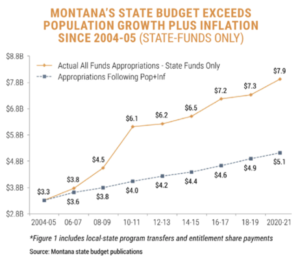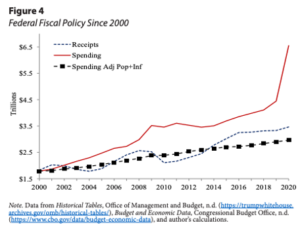The Montana Example
By adopting common-sense fiscal restraints like Montana and Texas have done, governments at all levels can start putting taxpayers first.
“Blessed are the young, for they shall inherit the national debt.” — President Herbert Hoover
This year, Governor Gianforte and the legislature followed our recommendations to pass a Conservative Montana Budget, protecting taxpayers by putting firm limits on spending growth – keeping spending below the growth of the economy, as measured by population growth plus inflation.
Our modeling shows that taxpayers would have saved billions if every budget passed for the last 16 years had been this fiscally conservative:

While Montana is keeping our fiscal house in order, it’s no secret that spending at the federal level is out of control. Our friends at the Texas Public Policy Foundation recently illustrated just how bad things really are:

TPPF’s modeling shows that federal taxpayers are on the hook for $3.6 TRILLION (around $10k per person) more than if spending had followed the more reasonable measure of U.S. population growth plus inflation. They recommend that Congress follow the lead of states like Montana and Texas to adopt a Responsible American Budget, which would place responsible limits on spending based on the growth of the national economy.
If Montana can balance the budget and hold the line on spending growth, why can’t Washington? For that matter, why can’t Missoula or Bozeman or any other government?
By adopting common-sense fiscal restraints like Montana and Texas have done, governments at all levels can start putting taxpayers first.
For Liberty
Kendall Cotton
. . .
The Latest
Regulations
1. New research from the Mercatus Center shows that regulatory budgeting – a policy that puts firm limits on the total burden of regulations on an economy – offers policymakers a very effective path to increasing economic growth without having to increase spending.
Our Take:
It’s clear that when regulators impose unnecessary restrictions that are costly for businesses to comply with, they harm economic growth. Thankfully, Lt. Governor Juras is leading Montana’s Red Tape Relief Task Force to address Montana’s regulatory burden head on. I look forward to the task force getting off the ground, considering regulatory budgeting and other innovative ways to reduce red tape and strengthen Montana’s economy.
DNA
2. Montana became the first state to pass a law limiting law enforcement’s use of online DNA databases to solve crimes.
“In Montana, law enforcement would need a warrant before using a DNA database unless the users waived rights to privacy.”
Our Take:
Consumer DNA databases like Ancestry.com let people upload their genetic information and use it to connect with relatives. Law enforcement officers have started using the databases to match DNA of potential suspects with relatives who are customers on the sites. Montana’s law is a step forward to ensuring that the privacy of people who use these services are protected.
Competitors Veto
3. From The Hill: “Gov. Gianforte deserves credit for working with the legislature to expand economic liberty. He signed two bills eliminating Montana’s ‘competitor’s veto’ requirements for moving companies and most health care facilities, which require entrepreneurs to get permission from their own competition in order to start a business. Such laws exist solely to protect incumbent businesses from upstart competition.”
Our Take:
We applaud Governor Gianforte for signing our proposal to repeal Montana’s Certificate of Need laws – a type of competitor’s veto for healthcare businesses.
